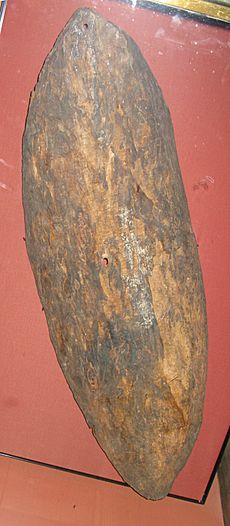Gweagal shield facts for kids
The Gweagal shield is an Aboriginal Australian shield. It was dropped by a Gweagal warrior. This happened when James Cook's group landed at Botany Bay on April 29, 1770. Joseph Banks found the shield and took it to England. Today, it's not clear if the original shield still exists. A shield in the British Museum was once thought to be the Gweagal shield. However, experts now believe it came from a different area. People are now campaigning to have this shield returned to Australia.
Contents
The Story of the Gweagal Shield
Cook's Landing and the Shield
In 1770, Captain James Cook arrived at Botany Bay. Two Aboriginal warriors from the Gweagal clan met his landing party. Cook's group tried to ask for water and offered gifts. The warriors threw stones and spears. Cook's party fired their muskets. One warrior was hurt, and both retreated. They left behind spears and a shield. Joseph Banks collected many spears. He likely took the shield back to England with him.
The Shield's Journey to England
A shield from "New Holland" (Australia) was among the items Banks brought to London in 1771. This shield had a hole near its center. Evidence suggests the shield might have gone from Banks to his servant, James Roberts. Later, a collector named John Bowes bought it. The shield is no longer at the Bowes Museum. Experts believe it might be in another museum. It could be in a collection that hasn't been fully checked or photographed yet.
The British Museum Shield
Is This the Gweagal Shield?
The British Museum has an Aboriginal shield. For a long time, they thought it was the one from Botany Bay. This shield was shown in Australia in 2015. It was part of an exhibition in Canberra. Dr. Shayne Williams, a Gweagal elder, saw the shield. He felt it didn't look like shields made in his area. He asked the British Museum to investigate where it really came from.
What the Experts Found
In 2016, the British Museum started to study the shield. They held a workshop with many experts. These included museum curators and university researchers. Two Aboriginal representatives from the La Perouse community also joined. Their findings were shared in 2018.
Tests showed the shield was made from red mangrove wood. This type of wood grows at least 500 kilometers north of Botany Bay. A ballistics expert checked the hole in the shield. They said it was not made by a gun. An expert named Nicholas Thomas also found that the British Museum shield does not match an old drawing of Banks's shield. Based on this, experts believe the British Museum shield is not the one taken from Botany Bay in 1770. It is likely a shield from north Queensland.
Campaign to Return the Shield
What is Repatriation?
After the exhibition, Rodney Kelly, a Gweagal man, started a campaign. He wants the shield returned to Australia. This is called repatriation. It means bringing cultural items back to their home country. He also wants some Aboriginal spears in England returned.
Different Views on Return
Rodney Kelly has visited Britain three times for his campaign. Australian politicians have supported his efforts. Nicholas Thomas, the expert, agrees that the shield should be returned. He says this is true even if it's not the original Gweagal shield.
However, the British Museum has said no to the request. British law does not allow them to return items in their collection. Gaye Sculthorpe, an Indigenous curator at the British Museum, believes the shield should stay. She thinks it helps tell the story of British and Aboriginal Australia to the world. Noeleen Timbery, a local Aboriginal leader, supports its return. She understands the museum has kept it safe.
Why the Shield is Important
The shield is very important to Aboriginal people. It reminds them of the first meeting between Aboriginal people and James Cook. This meeting was a difficult moment in history. Even if the British Museum shield is not the original, it is still very valuable. It is one of the oldest surviving shields from Australia's east coast. It shows a type of shield that is not well known. Experts say it is a very important part of Aboriginal heritage. Shayne Williams says the shield has strong meaning for all Aboriginal and Torres Strait Islander people.


